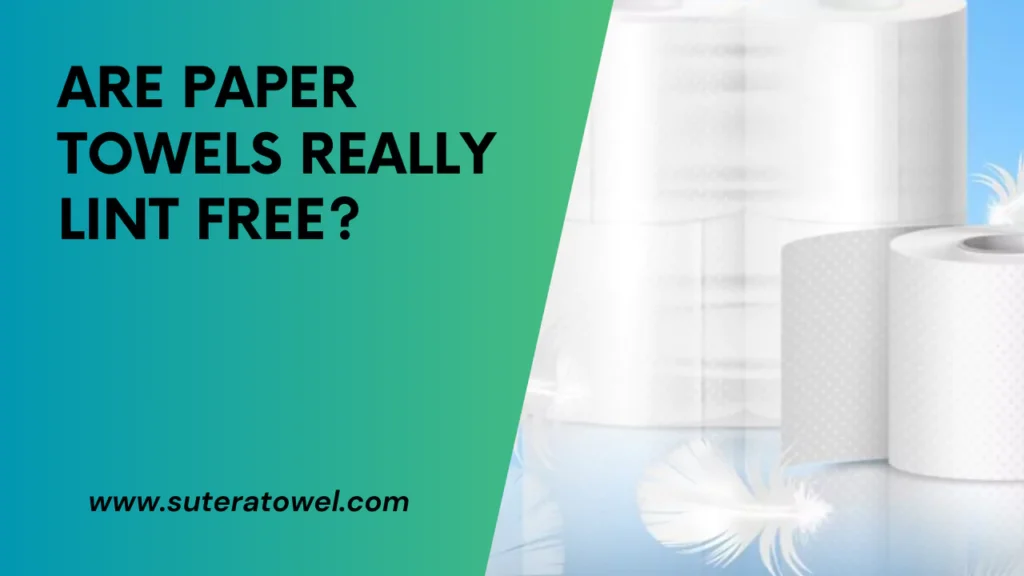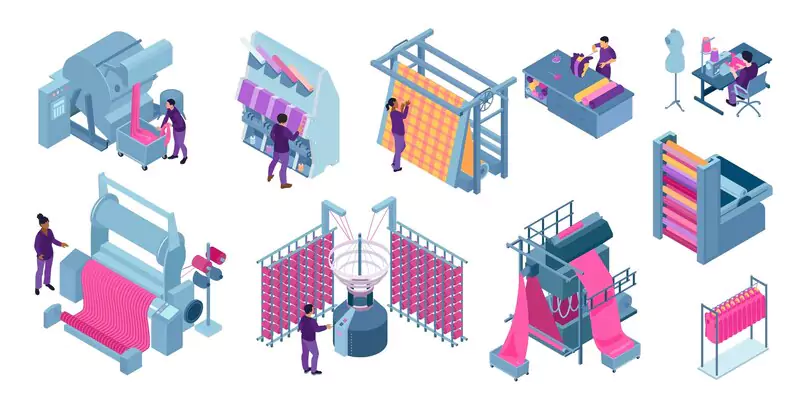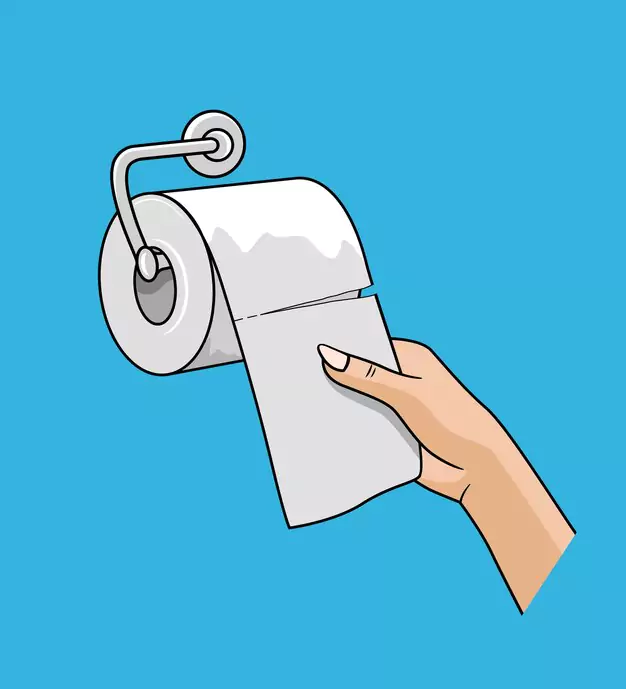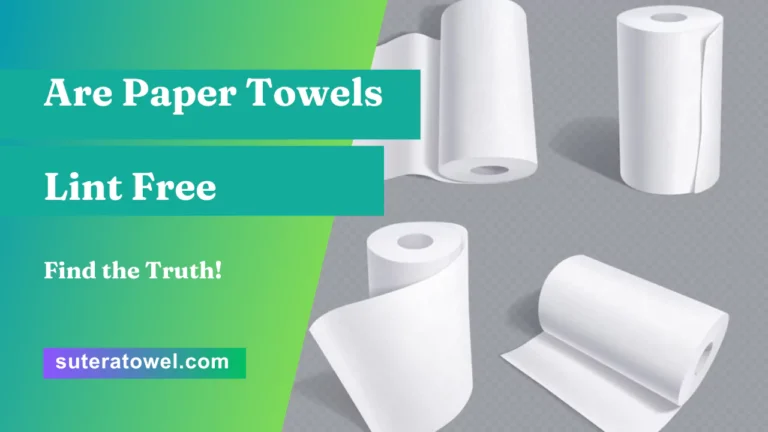Paper towels are not completely lint-free as they can still produce some lint. When used for cleaning or wiping surfaces, paper towels may leave behind small fibers or particles.
However, compared to other materials like cotton rags, paper towels generally have less lint.
- 1 Are Paper Towels Really Lint Free?
- 2 What Causes Lint In Paper Towels?
- 3 Evaluating The Lint-Free Claims
- 4 Absorbency And Lint Production
- 5 Texture And Lint Production
- 6 Other Factors Affecting Lint Production
- 7 Finding The Right Paper Towels For Your Needs
- 8 Frequently Asked Questions Of Are Paper Towels Lint Free
- 9 Conclusion
Are Paper Towels Really Lint Free?

Paper towels are not completely lint-free. While they may have small amounts of lint, they are generally designed to minimize lint and provide effective cleaning.
Myth Or Reality?
While paper towels are a common household item used for various cleaning purposes, the claim of them being lint-free is often debated. Let’s delve deeper into this topic to understand whether the assertion holds any truth.
Understanding The Concept Of Lint-Free
To determine whether paper towels are truly lint-free, it’s essential to grasp the meaning of the term “lint-free. ” Lint refers to small fibers or particles that can detach from a material, leaving residues or unwanted debris behind. Therefore, a lint-free material is one that does not shed or leave any fibers after use.
Factors That Affect Lint Production In Paper Towels:
Various factors can influence the lint production in paper towels. These factors should be taken into consideration when evaluating the claim of paper towels being lint-free. They include:
- Fiber quality: The quality of the paper fibers used in the manufacturing process can affect the level of lint produced. High-quality fibers tend to shed fewer particles.
- Manufacturing process: The technique used to transform the paper fibers into towels can impact lint production. Processes that involve strong bonding of fibers tend to reduce lint shedding.
- Texture and thickness: The texture and thickness of paper towels can influence the lint-free claim. Towels with a smoother texture and denser structure are less likely to shed fibers.
- Absorbency: Highly absorbent paper towels may have a higher chance of shedding fibers, leading to lint formation.
Overall, while paper towels may claim to be lint-free, it’s important to consider the aforementioned factors that can affect their lint production.
What Causes Lint In Paper Towels?
Lint in paper towels is caused by the fibers of the towel breaking down and becoming loose. While some paper towel brands claim to be lint-free, it is important to note that all paper towels, including those labeled as lint-free, have the potential to produce lint.
The Manufacturing Process Of Paper Towels:
- Paper towels are made through a multi-step process that involves cutting down trees, grinding them into pulp, and then pressing the pulp into thin sheets.
- These sheets are then dried using hot air or rollers to remove moisture and strengthen the fibers.
- The final step involves cutting the sheets into individual paper towel rolls or sheets.
Quality Of The Raw Materials Used:
- The quality of the raw materials used in paper towel production can impact the amount of lint produced.
- Higher-quality raw materials, such as longer and stronger fibers, tend to produce paper towels with less lint.
- Conversely, lower-quality or recycled fibers may result in paper towels that have more lint.
Bleaching And Other Chemical Treatments:
- Bleaching is a common chemical treatment used in paper towel manufacturing to achieve a bright white appearance.
- While bleaching can improve the aesthetics of paper towels, it can also make them more prone to linting.
- Other chemical treatments, such as softeners and additives, can also affect lint production in paper towels.
The Impact Of Ply And Embossing On Lint Production:
- Ply refers to the number of layers in a paper towel.
- Single-ply paper towels typically have more lint than multiple-ply options.
- Embossing, which creates a textured pattern on the surface of the paper towel, can also influence lint production.
- More heavily embossed paper towels tend to have higher lint levels compared to smoother varieties.
By understanding the manufacturing process, the quality of raw materials, the impact of chemical treatments, and the role of ply and embossing, it becomes clear why lint may be present in paper towels. Be mindful of these factors when selecting paper towel options that best suit your needs.
Evaluating The Lint-Free Claims
Evaluating the lint-free claims of paper towels is essential since paper towel and cotton rag usage can lead to lint. It’s important to understand that paper towel rolls and sheets may not be completely lint-free.
When it comes to paper towels, one of the most sought-after qualities is being lint-free. Many brands claim to have lint-free paper towels, but how accurate are these claims? In this section, we will evaluate the lint-free claims of paper towels using different testing methodologies, comparing various brands, and considering consumer experiences and reviews.
Testing Methodologies For Determining Lint Production
To determine the lint production of paper towels, several testing methodologies are used. These methodologies involve assessing the quantity of lint generated when the paper towel is used. Here are some common testing approaches:
- Rub Test: This involves rubbing the paper towel against various surfaces to determine the amount of lint it produces.
- Wet Strength Test: The wet strength of the paper towel is tested to evaluate its ability to hold up without shedding lint when wet.
- Air Test: This test involves swirling the paper towel in the air to see if it releases any particles or lint fibers.
Comparing Different Brands Of Paper Towels
When evaluating the lint-free claims of paper towels, it’s essential to compare various brands. Different brands may have different manufacturing processes and materials, which can impact their lint production. Here are some factors to consider when comparing different brands of paper towels:
- Fiber Composition: The type of fiber used in the paper towel can affect its lint-free properties. Some brands may use fibers that are less prone to shedding lint.
- Thickness and Density: Paper towels that are thicker and have a higher density tend to shed less lint.
- Manufacturing Techniques: The manufacturing process plays a crucial role in determining lint production. Brands that have optimized their production processes may produce paper towels with minimal lint.
Consumer Experiences And Reviews
To get a real-life perspective on the lint-free claims of paper towels, it’s essential to consider consumer experiences and reviews. Consumers who have used different brands of paper towels can provide valuable insights into their lint-free performance. Here are some consumer experiences and reviews to consider:
- Some consumers reported that certain brands of paper towels left behind minimal lint residue, indicating their lint-free properties.
- Others noted that even paper towels with lint-free claims still shed some lint, although to a lesser extent than non-lint-free paper towels.
- Consumer reviews can help determine which brands consistently provide lint-free paper towels and which ones may fall short of their claims.
By evaluating the lint-free claims of paper towels through testing methodologies, comparing different brands, and taking into account consumer experiences and reviews, we can gain a better understanding of the true lint-free capabilities of paper towels.
Absorbency And Lint Production

Paper towels are not completely lint-free. Paper fibers can break off and create lint when used for cleaning. While they are absorbent, you may still find some traces of lint left behind.
Relationship Between Absorbency And Lint:
- The absorbency of paper towels can directly impact the production of lint.
- Paper towels with higher absorbency tend to have a greater likelihood of producing lint.
- This is because the fibers in highly absorbent paper towels can break down more easily, leading to lint shedding.
- On the other hand, paper towels with lower absorbency may have a tighter weave, resulting in less lint production.
How Different Absorbency Levels Affect Lint Production:
- High-absorbency paper towels:
- These towels are designed to quickly soak up spills and moisture.
- The high absorbency can cause the fibers to loosen, resulting in more lint.
- They are more likely to leave behind lint on surfaces when used for cleaning.
- Low-absorbency paper towels:
- These towels have a tighter weave, reducing the likelihood of lint production.
- They may not be as effective at absorbing large spills or moisture quickly.
- Moderate-absorbency paper towels:
- These towels strike a balance between absorbency and lint production.
- They are less likely to leave behind lint compared to high-absorbency towels.
- They can still absorb a reasonable amount of moisture without excessive lint shedding.
Best Paper Towel Options For Minimizing Lint:
- Lint-free paper towels:
- Some manufacturers offer paper towels specifically marketed as lint-free.
- These towels have undergone processes to minimize lint production.
- They are typically made from materials with tighter weaves or have special coatings.
- Choose paper towels with lower absorbency:
- Paper towels with lower absorbency tend to have a tighter weave, reducing lint production.
- Look for towels labeled as “low-lint” or “less lint” to minimize the amount of lint left behind.
- Opt for recycled paper towels:
- Recycled paper towels are often made from a blend of fibers, which can result in a tighter weave.
- These towels may have a reduced likelihood of producing lint compared to non-recycled options.
Remember, while the absorbency of paper towels is important, it is essential to consider other factors such as strength and durability when choosing the best option for your specific needs.
Texture And Lint Production
Paper towels are not completely lint-free. While they may be advertised as such, they can still produce some lint when used. It’s important to understand that lint can come from both paper towels and cotton rags.
The Role Of Texture In Lint Production:
- Paper towel texture plays a crucial role in determining its lint production.
- The texture of paper towels refers to the surface design and composition, which can vary from smooth to textured.
- The texture affects how the paper towel absorbs liquids and traps particles, which in turn can impact lint production.
Smooth Vs. Textured Paper Towels:
- Smooth paper towels have a flat surface without any visible texture.
- A smooth surface allows for less friction and reduces lint production.
- Ideal for tasks that require minimal lint, such as cleaning glass or delicate surfaces.
- Textured paper towels have a raised pattern or embossed design on the surface.
- Textured surface creates more friction, leading to increased lint production.
- Suitable for tasks where lint is not a concern, such as general cleaning or absorbing spills.
Identifying Low-Lint Options For Specific Uses:
- When looking for low-lint paper towels for specific uses, consider the following options:
- Lint-free paper towels:
- These are specifically designed to minimize lint production.
- Ideal for tasks that require a lint-free surface, such as cleaning electronics or polishing surfaces.
- Heavy-duty industrial paper towels:
- These paper towels are designed for tough cleaning tasks.
- They are often more durable and less likely to leave lint behind.
- Bamboo paper towels:
- Bamboo paper towels are made from bamboo fibers, which are naturally lint-free.
- They are eco-friendly alternatives to traditional paper towels and offer low-lint properties.
- Reusable bamboo towels:
- These towels are washable and reusable, reducing waste and environmental impact.
- Made from bamboo fibers, they offer low-lint properties and can be used for various cleaning tasks.
Remember, understanding the texture of paper towels is essential in determining their lint production. Choose the right type of paper towel based on the specific use to minimize lint and achieve better cleaning results.
Other Factors Affecting Lint Production
Paper towels are not completely lint-free. Even though they are designed to minimize lint production, factors such as the type of paper used and the manufacturing process can still contribute to lint.
Lint production in paper towels can be influenced by several factors beyond the quality of the towels themselves. Understanding these other factors can help you choose the right paper towels for your needs and minimize lint-related issues. Here are some key factors to consider:
Environmental Conditions And Humidity:
- Humidity levels in the environment can affect the amount of lint produced by paper towels. High humidity can lead to increased lint, while lower humidity can result in less lint.
- Moisture in the air can cause paper towel fibers to become more prone to shedding, increasing lint production.
- It is important to note that the impact of environmental conditions on lint production can vary depending on the specific brand and type of paper towel.
User Techniques And Handling Methods:
- The way you use and handle paper towels can impact the amount of lint they produce.
- Aggressive scrubbing or rubbing motions when drying surfaces can cause more fibers to detach from the towel, leading to increased lint.
- Gentle patting or blotting motions are less likely to generate lint.
- It is also important to avoid overusing a single paper towel. Using a fresh towel when the current one becomes saturated can help reduce lint transfer.
How Storage And Packaging Can Impact Lint Production:
- The way paper towels are stored and packaged can also affect the amount of lint they produce.
- If towels are stored in a dusty or lint-prone environment, they may accumulate more lint particles over time.
- Poorly designed packaging that allows for excessive movement or rubbing of towels can cause additional lint production.
- Opting for tightly sealed packaging and storing towels in a clean, dry space can help minimize lint issues.
By considering these other factors affecting lint production, you can make better-informed decisions when selecting and using paper towels. Understanding how environmental conditions, user techniques, and storage/packaging practices influence lint can help you find paper towels that meet your needs and provide a more lint-free experience.
Finding The Right Paper Towels For Your Needs

When it comes to finding the right paper towels for your needs, it’s important to consider whether they are lint-free. Lint-free paper towels are highly desirable as they leave no residue behind, making cleaning tasks a breeze.
Understanding Your Specific Requirements:
- Different tasks require different paper towel qualities, and understanding your specific needs is crucial in finding the right paper towels.
- Consider the following factors:
- Absorbency: Determine the level of absorption needed for your task.
- Strength and durability: Assess how much strength and durability your task requires.
- Lint-free: Decide if lint-free paper towels are necessary for your specific application.
- Size and thickness: Consider the appropriate size and thickness for your needs.
- Environmental impact: Evaluate whether eco-friendly options are important to you.
Factors To Consider When Purchasing Paper Towels:
- Absorbency: Choose paper towels with high absorbency to tackle tough spills effectively.
- Strength and durability: Look for paper towels that are strong and durable enough to handle rigorous cleaning tasks without tearing.
- Lint-free: If you need lint-free paper towels for tasks such as cleaning glass or delicate surfaces, opt for brands that specifically mention lint-free properties.
- Size and thickness: Consider the size and thickness of the paper towels based on the task at hand. For larger messes, select bigger-sized sheets, while thinner options might be suitable for lighter cleaning.
- Environmental impact: If sustainability is important to you, prioritize eco-friendly options made from recycled materials or bamboo.
Recommendations For Low-Lint Paper Towel Brands:
- Bounty: Known for its excellent absorbency and strength, Bounty paper towels are a popular choice for both household and commercial use.
- Bambooee: Environmentally friendly and made from bamboo, bamboo paper towels offer a lint-free cleaning solution with great durability.
- Kirkland Signature: Kirkland Signature paper towels are lauded for their absorbency and strength, making them ideal for heavy-duty cleaning tasks.
- Blue Scott: Blue Scott paper towels are designed to be lint-free, making them a suitable choice for delicate cleaning tasks and surfaces.
Remember, finding the right paper towels for your needs is a matter of assessing the specific requirements of your tasks, considering factors like absorbency, strength, lint-free properties, size, thickness, and environmental impact. Luckily, there are various brands available that cater to different needs, ensuring you can find the perfect paper towels for any cleaning or wiping task you encounter.
Frequently Asked Questions Of Are Paper Towels Lint Free
Is Paper Towel Considered Lint Free?
Paper towels are not considered lint-free as they can result in lint due to the paper fiber composition.
Do Paper Towels Leave Lint?
Yes, paper towels can leave lint.
What Is The Best Lint Free Paper Towel?
The best lint-free paper towel is one that is made with high-quality fibers and has a strong absorbency.
What Material Is Lint Free?
Paper towels are considered lint-free.
Conclusion
Paper towels are a convenient and versatile tool for cleaning up spills and messes. However, when it comes to determining whether paper towels are lint-free, the answer is not so straightforward. While some brands may claim to be lint-free, the reality is that paper towels, by their very nature, can still leave behind small fibers or lint particles.
This is due to the composition of the paper fibers themselves. Despite this, many paper towels do a good job of minimizing lint, making them suitable for various household tasks. It’s important to choose a high-quality paper towel brand and consider the intended use when selecting a lint-free option.
Ultimately, whether a paper towel is lint-free or not depends on individual expectations and preferences. So, when reaching for a paper towel, keep in mind that while they may not be completely lint-free, they still offer great absorbency and convenience for everyday cleaning tasks.

